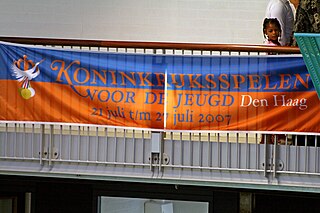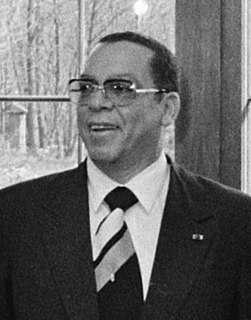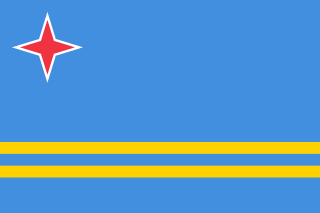
The Netherlands Antilles was a constituent country of the Kingdom of the Netherlands. The country consisted of several island territories located in the Caribbean Sea. The islands were also informally known as the Dutch Antilles. The country came into being in 1954 as the autonomous successor of the Dutch colony of Curaçao and Dependencies, and was dissolved in 2010. The former Dutch colony of Surinam, although it was relatively close by on the continent of South America, did not become part of Netherlands Antilles but became a separate autonomous country in 1954. All the island territories that belonged to the Netherlands Antilles remain part of the kingdom today, although the legal status of each differs. As a group they are still commonly called the Dutch Caribbean, regardless of their legal status.

The flag of the Netherlands Antilles was white, with a horizontal blue stripe in the center, one-third of the flag's hoist, superimposed on a vertical red stripe of the same width, also centered; six white, five-pointed stars are arranged in a pentagon pattern in the center of the blue band, their points up. It was adopted on 19 November 1959.

Bonaire is an island in the Leeward Antilles in the Caribbean Sea. Its capital is Kralendijk, located near the ocean on the lee side of the island. Aruba, Bonaire and Curaçao form the ABC islands located less than one hundred miles northwest of Venezuela. Unlike much of the Caribbean region, the ABC islands lie outside Hurricane Alley. The islands have an arid climate that attracts visitors seeking warm, sunny weather year round. Bonaire is a popular snorkeling and scuba diving destination because of its multiple shore diving sites and easy access to the island's fringing reefs.
Aruba's first inhabitants were the Caquetio Indians from the Arawak tribe, who migrated there from Venezuela to escape attacks by the Caribs. Fragments of the earliest known Indian settlements date back to about 1000. Due to Aruba's mostly distant location from other Caribbean islands and strong currents in the sea which made canoe travel to the other islands difficult, the Caquetios remained more tied to South America than the Caribbean.

Gilberto François "Betico" Croes was an Aruban political activist who was a proponent of Aruba's separation from the rest of the Netherlands Antilles. This eventually occurred, but Croes lapsed into a coma after an accident on 31 December 1985 and was never conscious to see his accomplishment. He is called the father of the Aruban nation.
The Constitution of the Netherlands Antilles was proclaimed on 29 March 1955 by Order-in-Council for the Kingdom. Its proclamation was specifically mandated by article 59(4) of the Charter for the Kingdom of the Netherlands, which had been enacted on 15 December 1954. Together with the Island Regulation of the Netherlands Antilles, the Constitution describes the foundation of the government of the Netherlands Antilles.
Same-sex marriages are not performed in Aruba, Curaçao, or Sint Maarten, which are constituent countries of the Kingdom of the Netherlands. The islands were, however, obliged after several court rulings to register any marriage registered in the Kingdom, but they don't have to give same-sex marriages the same legal effect as opposite-sex marriages. As marriage in the European territory of the Netherlands, as well as in the Caribbean Netherlands is open to any two people, marriages performed there have to be registered in the islands.
A federacy is a form of government where one or several substate units enjoy considerably more independence than the majority of the substate units. To some extent, such an arrangement can be considered to be similar to asymmetric federalism.

The Charter for the Kingdom of the Netherlands describes the political relationship between the four countries that constitute the Kingdom of the Netherlands: Aruba, Curaçao, and Sint Maarten in the Caribbean and the Netherlands in Europe. It is the leading legal document of the Kingdom. The Constitution of the Netherlands and the Basic Laws of the three other countries are legally subordinate to the Charter.

The Netherlands Antilles was an autonomous Caribbean country within the Kingdom of the Netherlands. It was dissolved on 10 October 2010.

The Kingdom Games were a multi-sport event that was held every two years between the youth of the countries that were part of the Kingdom of the Netherlands. At the final edition in 2009, these countries were the Netherlands, the Netherlands Antilles and Aruba. The 2010 dissolution of the Netherlands Antilles led to the cancellation of the 2011 and 2013 editions of the Games, and ultimately the Games were discontinued in 2014.

The Netherlands Antilles participated at the Olympic Games from 1952 until 2008. As a constituent country of the Kingdom of the Netherlands, it supported the Netherlands' boycott of the 1956 Games and also joined the American-led boycott of the 1980 Summer Olympics. The Netherlands Antilles participated in the Winter Olympic Games twice.

Juancho Evertsz, whose full name was Juan Miguel Gregorio Evertsz, was a Dutch Antillean politician who served as the Prime Minister of the Netherlands Antilles between 1973 and 1977.

The Kingdom of the Netherlands, commonly known as the Netherlands, is a sovereign state and constitutional monarchy with the large majority of its territory in Western Europe and with several small island territories in the Caribbean Sea, in the West Indies islands.

A status referendum was held on the island of Curaçao on 19 November 1993. The referendum was the result of a discussion about the future of the Netherlands Antilles, following the secession of Aruba in 1986. While most politicians, including the government of the Netherlands Antilles and the island government campaigned in favour of secession to make it form a country of its own within the Kingdom of the Netherlands, the option of retaining and restructuring the Netherlands Antilles received the most votes. This resulted in the rise of the Party for the Restructured Antilles, which won the 1994 general elections in the Netherlands Antilles.

A status referendum was held on the island of Sint Maarten in October 1994. The referendum was the result of a discussion about the future of the Netherlands Antilles, following the secession of Aruba in 1986. While most politicians, including the government of the Netherlands Antilles and the island government campaigned in favour of secession of Sint Maarten to make it form a country of its own within the Kingdom of the Netherlands, the option of retaining and restructuring the Netherlands Antilles came out in favour. This resulted in the rise of the Party for the Restructured Antilles.
A status referendum was held on the island of Saba on 5 November 2004.

The Dutch Caribbean are the territories, colonies, and countries, both former and current, of the Dutch Empire and the Kingdom of the Netherlands that are located in the Lesser Antilles archipelago of the Caribbean Sea.













